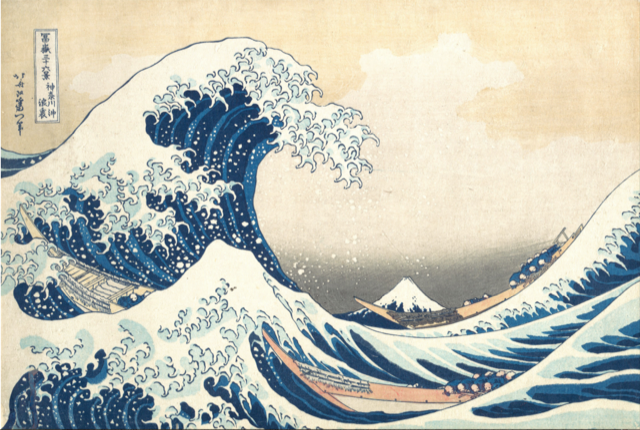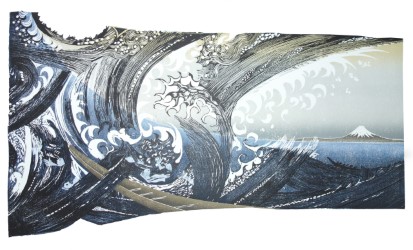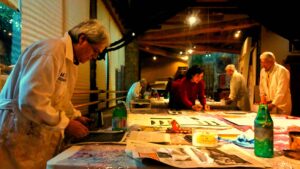
This article was published in Resurgence Journal, May 2017 by printmaker Rod Nelson.
Often the greatest artists make it easy for almost anyone to appreciate their work. Their work seems ‘natural’. Although a lengthy intellectual and aesthetic apprenticeship may be required to fully appreciate such masters as Shakespeare, Bach, Van Gogh, Turner, Picasso and Goya, even the untutored eye or ear is able to take a pleasure or amazement from a relatively casual encounter with their work. Hokusai is best known as a woodblock printmaker, and though print is sometimes perceived erroneously as a ‘secondary medium’, a short perusal of his work dispels this notion absolutely. In Hokusai’s hands, printmaking stands the equal of any other artistic medium.
Let us consider for a moment Hokusai’s woodcut ‘The Great Wave at Kanagawa’ – probably the best-known woodcut print of all time – there is hardly anyone who is not excited by this masterpiece when seeing it for the first time (or even for the hundredth). It is visually as accessible to a six year old as to a Professor of Art. Hokusai portrays the wave as shaving the quality of a magnificent predatory beast, which hovers, as time freezes for a millisecond, with its hungry claws spread above the huddling mariners who are utterly at its mercy. As Hokusai portrays this instant, their fate is undecided. The more one moves into an image such as this and the artists of Hokusai’s stature who are capable of making such art, the more dimensional, the more awesome and mysterious their work becomes. I like to think that in the pantheon of the very highest achievement of artistic possibility, chuckles Hokusai, relishing his place. He knew that he was good.
If we choose for a moment to go deeper into who Hokusai might have been as a person and as an artist, what we find is extraordinary and certainly unexpected. Take for example his ‘Japaneseness’. Japanese culture is an astonishing legacy, but there is a notion of the Japanese aesthetic as perhaps being tightly bound by culture or convention. Hokusai isn’t like this at all. He constantly exceeds bounds – not for him the meek dedication of the traditional artist-craftsman. He is acquainted to some extent with the world outside Japan. He is a teacher, a social person, a maverick, a self-promoter, financially successful, full of confidence and something of a rebel, restless.Two stories about his life illustrate this.
One story has him in direct competition with a traditional brush artist in front of the Shogun Iyenari. Hokusai lays down with his brush a great blue curve on paper, then chases across it a chicken whose feet had been dipped in red paint. With a flourish, he calls his and the chicken’s work, ‘Tatsuta River with red maple leaves floating’ and promptly wins the competition. On another occasion, during the Tokyo festival in 1804, he created a portrait of the Buddhist priest Daruma said to be 600 feet (180 m) long using a broom and buckets full of ink.
When we think about what the word ‘multiple’ can mean in an artistic context, Hokusai might even set the standard. He chose to have at least thirty one names during his lifetime. The name by which we know him isn’t his ‘birth’ name, and Hokusai Katsushika simply means ‘North Studio in Katsushika province’. He was born Tokutara ….but was commonly known at different times as Shunro, TawarayaSori, Kakō, Tatsumasa, Gakyōjin, Taito, Iichi, and Manji (and those are merely the better-known ones). Can each of these names have represented a semi-individuated artist in their own right? It is hardly possible to imagine, for someone so prolific, dedicated and fluent as the person we know as Hokusai that they weren’t. His name changes are known to be associated with changes in his style of work. Hokusai must have been exploring in an extended and profound way what it might be like to have multiple artistic personae, and though we can’t ask him directly, maybe multiple personalities.
Hokusai’s restlessness takes a spiritual form. His description of his own quest, which he wrote late in his life sums this up.
‘‘From the age of six, I had a passion for copying the form of things and since the age of fifty I have published many drawings, yet of all I drew by my seventieth year there is nothing worth taking in to account. At seventy-three years I partly understood the structure of animals, birds, insects and fishes, and the life of grasses and plants. And so, at eighty-six I shall progress further; at ninety I shall even further penetrate their secret meaning, and by one hundred I shall perhaps truly have reached the level of the marvellous and divine. When I am one hundred and ten, each dot, each line will possess a life of its own.’
As one reads this, the effort of this artist to understand Nature goes beyond intellect, beyond conditioning, and beyond all convention. It is a total immersion of his being into observation. It is absolute commitment of soul and skill. It strikes this writer that though Hokusai has a superbly developed aesthetic sensibility, he isn’t first and foremost an aesthete. His short autobiographical piece tells us unambiguously that his interest goes beyond making lovely prints of beautiful places and things: his vocation is self-realisation through his work. That is a Taoist, a Buddhist, and a Japanese tradition.
To attempt a critique of such an artist would be impious, and though scholars might enjoy to make a comparative study of Hokusai from a Western standpoint, the relevance and excitement generated by his work, and its enduring popularity really speaks for itself.
The first quality of Hokusai for the present day artist to wonder at is his fluency, his wonderful abundance. This appears a common feature amongst the greatest artists….and is a quality he shares with Hockney, or Picasso, or Bach …the list goes on. The work pours forth, like a river. Hokusai produced a simply enormous amount of work, of which the masterly 39 Views of Mount Fuji are perhaps the most widely known. There are volumes upon volumes of prints, drawings and sketches, storybooks, erotic art and commissions. As a family man, he must have found it necessary to couple self-promotion and the requirements of the breadwinner with very diligent creative effort throughout his long life.
Technical mastery comes with great application and practice. Like a great musician, he can consistently amaze, charm, shock, and persuade by turns. The flawless draughtsmanship and quality of line coupled with an amazing grasp of ‘the moment’ – the sense of action and movement is a delight. He is a great documenter, and any subject, no matter how small or passing, how common or intimate, is grist to his artistic mill. Yet alongside this sometimes almost journalistic quality, recording the life of his times, is an instinct for the graphical beauty within abstract form. He trips lightly from semi-realism to abstraction and back again. His work can encompass the ethereal sense of space of the Chinese landscape mastersor equally, the rumbustious proletarianism of Brueghel.
He works and works at his art, for its own sake and here is his restless vocation. He writes of his desire to become immortal in order to reach the essence of art itself. The word religion is derived from re-ligare – to bind again. One senses his wish to bind himself to the source, Nature through his own sense of duty towards his art. The ardour of his longing for exceptional quality is pitched at ‘the secret meaning’ of life, beyond time, beyond fashion, beyond style.
How much there is to learn from a life lived so productively. As a printmaker I find him absolutely inspiring.

Rod Nelson is a respected printmaker from the UK who has exhibited at the Royal Academy, London at the Royal West of England Academy, Bristol and recently returned from a residency in Wuerttemburg, Germany. His print ‘High Falls 1’ was selected in December 2017 for the Winter exhibition of the International Print Center of New York and subsequently at the Royal Academy Summer Exhibition in London where the entire edition of 50 copies sold out.

